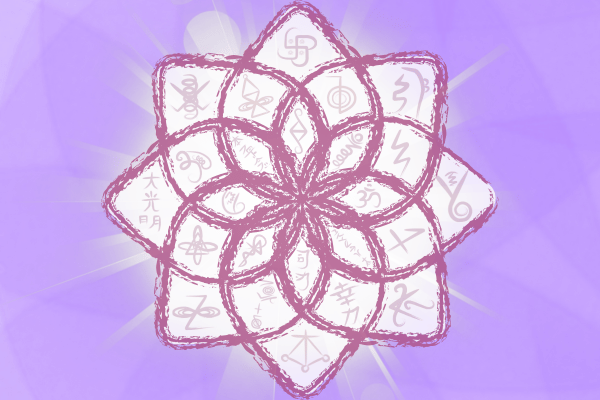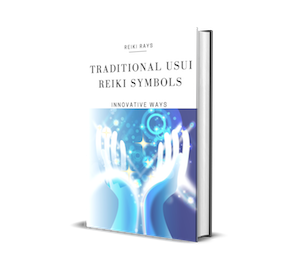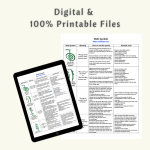My Journey into the Study of Reiki Symbols
For over 30 years, I have observed the development of Reiki, particularly its symbols. Since childhood, I have been fascinated by Japanese culture and spirituality. This passion led me to study the Japanese language and its script in depth.
My Reiki teacher once asked me to create calligraphies of the symbols for her—a request that ignited my passion for calligraphy. Later, while studying Japanology and East Asian art history, I discovered numerous references to the Master Symbol in Buddhist sutras. In a Japanese temple, I found the origin of the Mental Healing Symbol engraved on a stone pagoda. This discovery profoundly shaped my research and offered me new insights into Reiki symbols. These deep experiences and findings eventually led me to establish my own Reiki style: Shingon Reiki.
Traditional Use of Symbols and Their Evolution Over Time
In the 1990s, Reiki symbols were still used in a relatively traditional manner: drawn in the air with the dominant hand, visualized, and activated by repeating the mantra three times.
As Reiki spread, secrecy surrounding the symbols led to many variations, making it difficult to determine their original forms. A similar process occurred with Reiki attunements—some practitioners introduced their own symbols that had nothing to do with Reiki, creating confusion. At the same time, a belief emerged that the exact appearance or pronunciation of the symbols was secondary, and that only the practitioner’s intention mattered.
The Digital Shift: Reiki via the Internet
About 20 years ago, I began experimenting with digital Reiki. I tested what would happen if I placed my hands in front of a camera, recorded Reiki energy, and then played the video.
To my surprise, people responded strongly: visitors came to my website daily to receive Reiki energy from the video. This laid the foundation for many Reiki practitioners who now offer energy healing through platforms like YouTube and TikTok.
Hybrid and Online Reiki—Does It Really Work?
In my hybrid Reiki events, where participants join both in-person and online, I consistently experience how powerfully Reiki can be transmitted over distance. We feel a profound connection to one another.
Even during online attunements, participants report that they can clearly sense when I am working with them—such as when I blow energy toward them, even though I am not physically present. Many who have experienced both online and in-person attunements say they actually feel more during the online sessions because they are less distracted by physical sensations.

Traditional vs. Modern Use of Symbols
The question of whether traditional applications of symbols are as effective as modern digital methods remains an intriguing one. For example, the Distance Healing Symbol seems unnecessary in an online setting. From a Buddhist perspective, space does not separate us—it connects us. Thus, Reiki transmitted via the internet functions similarly to an in-person session.
The ability to conduct Reiki sessions online has revolutionized practice. Clients can now relax while receiving distant healing through live video, with the practitioner observing and guiding them. While Reiki sessions traditionally took place on a massage table in a practice setting, followed by the rise of remote healings conducted via telephone, interactive online sessions are now a well-established alternative.
Different Ways of Applying Reiki
I recall a personal experience where I injured my hand while at sea. Direct hands-on healing did not bring any improvement, and gradually, my hand stiffened.
However, when I treated the joint in the aura instead of through physical touch, just 20 minutes of Reiki led to complete pain relief and restored full mobility. At a conference, I applied the same technique to straighten the pelvic misalignments of two dozen people at once. We also experimented with this method in a separate room behind a wall—and it worked just as effectively.
The Future of Reiki and Its Symbols
However, it is not that Reiki itself adapts to circumstances; rather, we continually discover new ways to apply Reiki as our understanding evolves. And we are certainly far from reaching the limits of what is possible.
This suggests that Reiki may be applicable in dimensions we have yet to explore. I am excited to see what new possibilities will emerge in the coming years.
Free eBook download: We’ve created an eBook with our best articles on this topic, and offer it for free to all our newsletter subscribers.


Mark Hosak is a Reiki Master Mentor, Buddhist Healer, and Founder of the Style Shingon Reiki.
He shows Reiki practitioners and Reiki masters how to enhance their Reiki skills and perception in order to awaken their innermost talents and live their true desires.
A Reiki practitioner since 1993 and a lover of ancient Japanese culture, Mark has been searching for the roots of Reiki and the Reiki symbols in the footsteps of Mikao Usui for more than 25 years. He studied Japanology and East Asian Art History at Heidelberg University, and lived for three years in Japan with two scholarships for research about the Reiki symbols and Buddhist rituals at Kyoto University. During his stay in Japan, he also became a calligrapher and a Buddhist monk.
With this knowledge, Mark founded in 2005 the Reiki style Shingon Reiki. This is traditional Usui Reiki, Kuji-Kiri and Kuji-In and Buddhist-Daoist healing with Mantras, Mudras, and symbols. Today he is giving training in Shingon Reiki, Buddhist and Daoist Healing, Tai Chi and Qigong in online courses in English and German.
Mark is the author of several books and articles on Reiki and the Buddhist Art of Healing in Esoteric Buddhism. He translates spiritual texts from classical Japanese and explains the connection between Japanese history, culture, religion, and spirituality to understand Reiki from its roots.
Websites: www.shingon-reiki.com
Facebook: Mark Hosak
Instagram: instagram.com/your_reiki_guide
YouTube: youtube.com/user/Markhosak





Leave a Reply